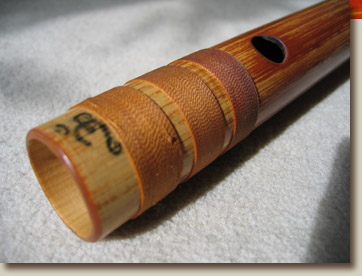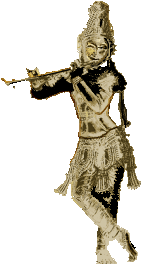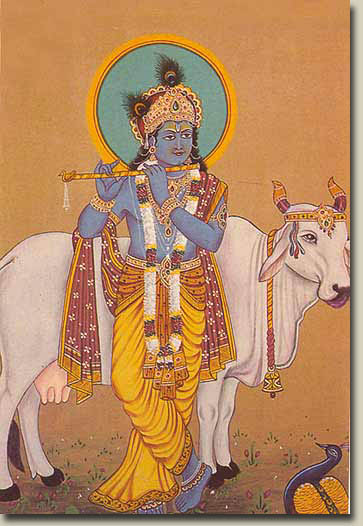 WDR 3 Musikpassagen, Ausschnitte vom 28.08.2007 und 26.10.2007
WDR 3 Musikpassagen, Ausschnitte vom 28.08.2007 und 26.10.2007
 WDR 3 Musikpassagen , Ausschnitte vom 08.10. 2007
WDR 3 Musikpassagen , Ausschnitte vom 08.10. 2007
(Radio-Interviews are in german)




the Bansuri, bamboo transverse flute
The Northern Indian term for this flute is Bansuri. The flute has many similarities with the human voice. They both have an average range of two-and-a-half octaves. The flute is made out of a piece of bamboo and has 7 holes, 6 for the fingers and one blowing hole.
The most important link is breath, the medium leading to sound production and expression.
Most of the delicate slidings, ornamentations and tonal variations essential to Indian music can be performed on bamboo flute.
The Bansuri occupies a special position in Indian culture as it is associated with the flute playing of Lord Krishna, the mythological reincarnation of the Hindu god Vishnu.
The basis of Indian classical music is the melodic system of Raga, played by the flute or any other instrument or vocalist, the rhythmic system of Tala, played by the Tabla, a pair of two hand-played drums, and the support of a drone, played on the Tanpura, a plucked stringed instrument with a long neck and gourd resonator.
A Raga is an unique melodic structure with possibilities of variation and improvisation. The permitted notes of the ascending and descending scale are fixed. Each Raga contains a different tonal material which is used only in that particular raga following definite rules becoming valid only in one specific raga.
The basic pitch is called Sa (the equivalent of the European tonique), and the other notes of the scale, in ascending order are Re, Ga, Ma, Pa, Dha, Ni and Sa an octave above.
Each Raga is considered to inspire a certain mood, each one is assigned to a time of day or night.
Raga means something like “colour”. It can be said to be a musical expression, said to evoke different kinds of moods in the audience. Every Raga has its own special expression and unique personality.
The first part of the Raga is the unmeasured Alap, in which the Raga gradually unfolds and its beauty and subtlety are explored. The tonal material is introduced and the mood is created. During this part the grace and smooth motions of vocal music are heard.
The second part of the Raga - the Jor- includes faster improvisations with a pulse. The notes of the scale are revealed and repeated rhythmically one after the other. After the exposition of the Raga (Alap, Jor), the Tabla (two hand-beaten drums) are introduced and from now on the music becomes bound by both Raga and Tala. This section is generally called the Gat. A Tala is a time cycle with a certain number of beats, which are arranged into particular groupings.
The compositions are set to various rhythmic cycles of 7,9,10,12 or 16 beats, in medium or fast tempo. During a raga performance the speed is raised continuously.
raga
There is a saying in Sanskrit - "Ranjayathi iti Ragah" - which means, "that which colours the mind is a raga."
For a raga to truly colour the mind of the listener, its effect must be created not only through the notes and the embellishments, but also by the presentation of the specific emotion or mood characteristic of each raga according to the time cycle.
Thus through rich melodies in Indian music, every human emotion, every subtle feeling in man and nature can be musically expressed and experienced.
The performing arts in India - music, dance, drama, and poetry - are based on the concept of Nava Rasa , or the "nine sentiments." In this context Rasa means "emotion" or "sentiment." The acknowledged order of these sentiments is as follows: Shringara (romantic and erotic): Hasya (humorous): Karuna (pathetic): Raudra (anger): Veera (heroic): Bhayanaka (fearful): Vibhatsa (disgustful): Adbhuta (amazement): Shanta (peaceful).
Each raga is principally dominated by one of these nine rasas, although the performer can also bring out other emotions less emphasised. The more closely the notes of a raga conform to the expression of one single idea or emotion, the more overwhelming the effect of the raga.
the times of indian ragas
Tradition ascribes certain ragas to particular times of the day or seasons which is called samay.
One of the unique characteristics of Indian music is the assignment of specific times of the day and night for performing Raga melodies. It is believed that only in this period the Raga appears to be at the height of its melodic beauty and majestic splendour. There are some Ragas which are very attractive in the early hours of the mornings; others which appeal in the evenings and others which spread their fragrance only near the midnight hour. It is said that appropriate performance may bring harmony, while playing at different times may bring disharmony.
There are some musicians who argue that a raga must be performed at the time of day that it is assigned; other musicians argue that one may play a raga at any time if one wishes to evoke the mood of that time.
This connection of time of the day or night with the Raga is based on daily cycle of changes that arise in our own body and mind which are constantly undergoing subtle changes in that different moments of the day stimulating different moods and emotions.
Each Raga is associated with a definite mood or sentiment that nature creates in human beings. Also each part of the day - such as the time before dawn, noon, late afternoon, early evening, late night - is associated with a specific sentiment. The explanation of the time associated with each raga may be found in the nature of the included notes, or in historical anecdotes concerning the raga.
Ancient musicologists were particularly interested in the effects of musical notes, how it effected and enhanced human behaviour. Music had the power to cure, to make you feel happy, sad, relaxed and so on. Extensive research was carried out to find out these effects. This formed the basis of today’s time theory.
It is believed that the human body is dominated by three different elements. These elements work in a cyclic order of rise and fall during the 24 hour period. Also, the reaction of these three elements differ with the seasons. It is said that performing or listening to a raga at the proper allotted time can even affect the health of human beings. Listening to music that is synchronized with the sympathetic overtones of the season, time and hour of the day makes us flow in harmony with our natural environment, saves energy, regulate our moods, and enhances our enjoyment of life.
In Indian music there is above all an awareness between man and nature, each acting and reacting on the other, and, depending upon the imagination and the creativity of an artist; a great artist can communicate and instil in his listener the mood of the Raga.
Another, important, aspect is the character, nature and mood of the artist and also the listeners temper. The artist can even take liberty to get all kinds of moods and atmospheres within one raga.